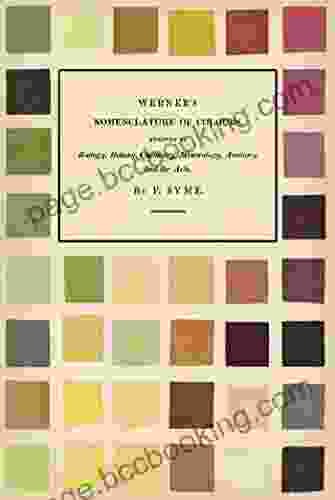
4.7 out of 5
| Language | : | English |
| File size | : | 13994 KB |
| Text-to-Speech | : | Enabled |
| Screen Reader | : | Supported |
| Enhanced typesetting | : | Enabled |
| X-Ray | : | Enabled |
| Word Wise | : | Enabled |
| Print length | : | 55 pages |
The Genesis of Colour Classification
Throughout history, humans have sought to understand and classify the captivating realm of colours. From the ancient Greeks and Egyptians to the Renaissance masters and modern-day scientists, countless individuals have dedicated their lives to unraveling the mysteries of the colour spectrum. One of the most significant milestones in this ongoing endeavor was the Werner Nomenclature of Colours, developed by the German mineralogist and chemist Martin Heinrich Klaproth in 1819.
Klaproth's groundbreaking work built upon the foundations laid by earlier pioneers, such as Sir Isaac Newton's pioneering studies on light and colour. However, it was Klaproth who devised a comprehensive and systematic approach to colour classification that remains unparalleled to this day.
The Principles of Werner's System
The Werner Nomenclature of Colours is based on three fundamental principles:
- Spectral origin: Colours are classified according to their spectral composition, whether they are derived from pure spectral hues, mixtures of spectral hues, or combinations of spectral hues and white light.
- Perceptual attributes: Colours are further characterized by their perceptual attributes, including hue, saturation, and lightness. Hue refers to the dominant colour, saturation indicates the intensity or purity of the colour, and lightness describes the relative amount of white or black in the colour.
- Logical organization: The colours are organized into a hierarchical system, with primary spectral hues at the core and secondary and tertiary hues derived from combinations of primary hues. The system also incorporates shades and tints, which are created by adding white or black to a given hue.
The result of Klaproth's meticulous approach is a comprehensive and coherent colour system that encompasses over 11,000 named colours, each with a unique identifier and precise description.
Applications in Art, Design, and Science
The Werner Nomenclature of Colours has found widespread applications across a diverse range of disciplines, including art, design, and science.
Art: Artists have long relied on the Werner Nomenclature to accurately identify and communicate specific hues and shades. The system's precise terminology provides a common language for artists to discuss colour theory, colour harmonies, and colour symbolism.
Design: Designers utilize the Werner Nomenclature to develop consistent colour schemes and palettes. The system's comprehensive range of colours and its logical organization make it an invaluable tool for creating visually appealing and effective designs.
Science: Scientists, particularly in the fields of mineralogy, geology, and chemistry, use the Werner Nomenclature to describe and identify minerals and other materials based on their colour characteristics. The system's objectivity and precision make it an essential tool for scientific research and documentation.
Beyond Colour Classification
The Werner Nomenclature of Colours is more than just a colour classification system. It is a testament to human ingenuity and our relentless pursuit of understanding the natural world. By providing a precise and comprehensive framework for describing colours, Klaproth's work has not only advanced our knowledge of colour theory but has also opened up new avenues for artistic expression, design innovation, and scientific discovery.
As we continue to delve into the intricacies of the colour spectrum, the Werner Nomenclature of Colours will undoubtedly remain an indispensable resource for generations to come.


























































































